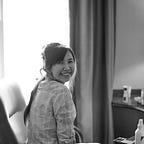On becoming a better teacher
My teaching journey had a typical start: my graduate fellowship had run out, and I needed tuition waivers and stipend. The gossip among graduate students painted a gloomy picture on teaching. “Undergrads are lazy and annoying,” they said. Horror stories were passed around during TA orientations and happy hours, and received unanimous sympathy from TA peers. Though whose story was the best remained to be determined, it was agreed upon that teaching was unpleasant, powerless, and time-consuming at best.
My first day teaching a face-to-face discussion section felt like being dropped off at preschool for the first time. I didn’t want to go in. What if I couldn’t explain this stuff well enough to my students? What if I don’t know the answers to their questions? What if they don’t understand my English? I remember asking, as an icebreaker,how their summer was, and someone answered grumpily “It’s already over.” I remember my shaking voice as I rushed through mitosis and meiosis. I remember running out of time. Students started packing up, their faces said “This semester is gonna suck. I’m stuck with a bad TA.”
That semester was not even my first TA appointment. I had assisted in Genetics Laboratory, a lab course, and Genetics and Society, a writing intensive course. But in the lab course, I had only helped set up experiments, troubleshoot microscopes and computers, and occasionally answer students’ questions. The professor had been present in the room, and the students had spent most of their time working on their own. In Genetics and Society (the writing course), I had been more or less a grader. My interactions with students had been mostly through written comments on their essays.
So it wasn’t until a TA appointment in General Genetics placed me in front of three weekly discussion sections, each had 25 sophomores, that I had to teach on my own. I had to plan lessons, then deliver them, and answer questions. And I had to be in the room with students. Just me and them.
I plowed through. I stayed up late studying the preset slides, making sure I understand them. I looked up the pronunciation of difficult words (“heterozygosity”). I rehearsed, every single week, with my very patient partner. Still, I felt nervous and uncertain about my teaching.
And I had to be in the room with students. Just me and them.
It was my students who calmed me down. By the middle of the semester, I asked them for anonymous feedback on index cards. The cards came back, and as I read through them, I started to breathe easily.
“You’re very informative and explain the material in a simpler, more step-by-step way.”
“Linh, you are very well-prepared. Discussion is very helpful.”
“I love discussion. You make things easy to understand. Keep going! Thank you!”
I kept going. My experience from the lab course and the writing course came in to help with teaching General Genetics that semester. I knew how things work in the lab, I had examples to show, and I had abundance of stories to tell. Because I had been familiar with the empirical side and the applications of the content I was teaching, I often had the answers to my students’ questions. Even when I didn’t, I could comfortably say “I don’t know. Why don’t we look that up together?”
As I became more comfortable with teaching, I started trying different strategies to see if they help students learn. I showed more videos and animations in class. Then, upon realizing that staring at a glowing screen — even when it was showing DNA replication — was a passive activity, I started making worksheets with guiding questions and fill-in-the-blanks exercises for students to complete when they were watching the videos. Gradually, I switched from a presenter who delivered given materials to an instructor who set up classroom activities.
I started trying different strategies to see if they help students learn.
When I taught General Genetics the second time, I was also taking a graduate course in College Science Teaching. The course changed my ideas about teaching. I started thinking in a goal-oriented way: effective teaching was not simply about showing Pixar-quality animations or having the most interesting activity; it was to help students achieve certain learning goals. Since then, learning goals became my anchor as I planned lessons. Classroom activities came together more coherently and logically as they were set up to achieve the same goals. Learning goals were visible checkmarks: they helped students realize where they were and how much progress they made over time.
By the third year of teaching General Genetics, I have decided to pursue teaching as my career. Between a graduate minor in college teaching and an M.A. thesis in college genetics education, I was constantly reading, thinking, and reflecting about teaching. I got to work with colleagues and mentors who were devoted teachers, to learn from them, and to share my thoughts with them. Teaching, in my mind, has gone from an untrainable mythical creature to an elegant craft that I enjoy. Like other learnable but challenging skills, teaching requires patience, passion, and practice.
